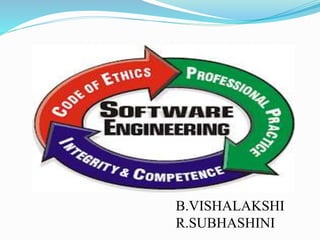
What is Software Engineering? Key Concepts and Processes Explained
- 2. What is Software? The product that software professionals build and then support over the long term. Software encompasses: (1) instructions (computer programs) that when executed provide desired features, function, and performance; (2) data structures that enable the programs to adequately store and manipulate information and (3) documentation that describes the operation and use of the programs.
- 3. Software products Generic products Stand-alone systems that are marketed and sold to any customer who wishes to buy them. Examples – PC software such as editing Customized products Software that is commissioned by a specific customer to meet their own needs. Examples – embedded control systems, air traffic control software, traffic monitoring systems.
- 4. Why Software is Important? The economies of ALL developed nations are dependent on software. More and more systems are software controlled ( transportation, medical, telecommunications, military, industrial, entertainment,) Software engineering is concerned with theories, methods and tools for professional software development. Expenditure on software represents a significant fraction of GNP in all developed countries.
- 5. Software Applications 1. System software 2. Application software 3. Engineering/scientific software 4. Embedded software 5. Product-line software 6. WebApps 7. AI
- 6. Engineering Engineering is … The application of scientific principles and methods to the construction of useful structures & machines Examples Mechanical engineering Computer engineering Civil engineering Chemical engineering Electrical engineering Nuclear engineering Aeronautical engineering
- 7. Software Engineering • Software Engineering is the science and art of building significant software systems that are: 1) on time 2) on budget 3) with acceptable performance 4) with correct operation.
- 8. Software Costs Software costs often dominate system costs. The costs of software on a PC are often greater than the hardware cost. Software costs more to maintain than it does to develop. Software engineering is concerned with cost-effective software development.
- 10. The Software Process Structured set of activities required to develop a software system Specification Design Validation Evolution Activities vary depending on the organization and the type of system being developed. Must be explicitly modeled if it is to be managed.
- 11. Engineering Process Model Specification: Set out the requirements and constraints on the system. Design: Produce a model of the system. Manufacture: Build the system. Test: Check the system meets the required specifications. Install: Deliver the system to the customer and ensure it is operational. Maintain: Repair faults in the system as they are discovered.
- 12. Software Engineering is Different Normally, specifications are incomplete. Very blurred distinction between specification, design and manufacture. No physical realization of the system for testing. Software does not wear out - maintenance does not mean component replacement.
- 13. Generic Software Process Models Waterfall Separate and distinct phases of specification and development Evolutionary Specification and development are interleaved
- 14. Requirements definition System and software design Implementation and unit testing Integration and system testing Operation and maintenance Waterfall process model
- 16. Hybrid Process Models Large systems are usually made up of several sub-systems. The same process model need not be used for all subsystems. Prototyping for high-risk specifications. Waterfall model for well-understood developments.
- 17. Process Model Problems Waterfall High risk for new systems because of specification and design problems. Low risk for well-understood developments using familiar technology. evolutionary Low risk for new applications because specification and program stay in step. High risk because of lack of process visibility. hybird High risk because of need for advanced technology and staff skills.
- 18. Process Visibility Software systems are intangible so managers need documents to assess progress. Waterfall model is still the most widely used model.
- 19. Ethical Issues Confidentiality Competence Intellectual property rights Computer misuse
- 20. Software Development Stages Requirements Analysis & Specification Implementation/Coding System Testing/Validation System Delivery/Deployment Maintenance
- 21. Component-based software engineering Based on systematic reuse where systems are integrated from existing components or COTS (Commercial-off- the-shelf) systems. Process stages Component analysis; Requirements modification; System design with reuse; Development and integration. This approach is becoming increasingly used as component standards have emerged.
- 22. Software evolution Software is inherently flexible and can change. As requirements change through changing business circumstances, the software that supports the business must also evolve and change. Although there has been a demarcation between development and evolution (maintenance) this is increasingly irrelevant as fewer and fewer systems are completely new.
- 23. Computer-aided software engineering Computer-aided software engineering (CASE) is software to support software development and evolution processes. Activity automation Graphical editors for system model development; Data dictionary to manage design entities; Graphical UI builder for user interface construction; Debuggers to support program fault finding; Automated translators to generate new versions of a program.
- 24. conclusion Software processes are the activities involved in producing and evolving a software system. General activities are specification, design and implementation, validation and evolution. Software process models are abstract representations of these processes.